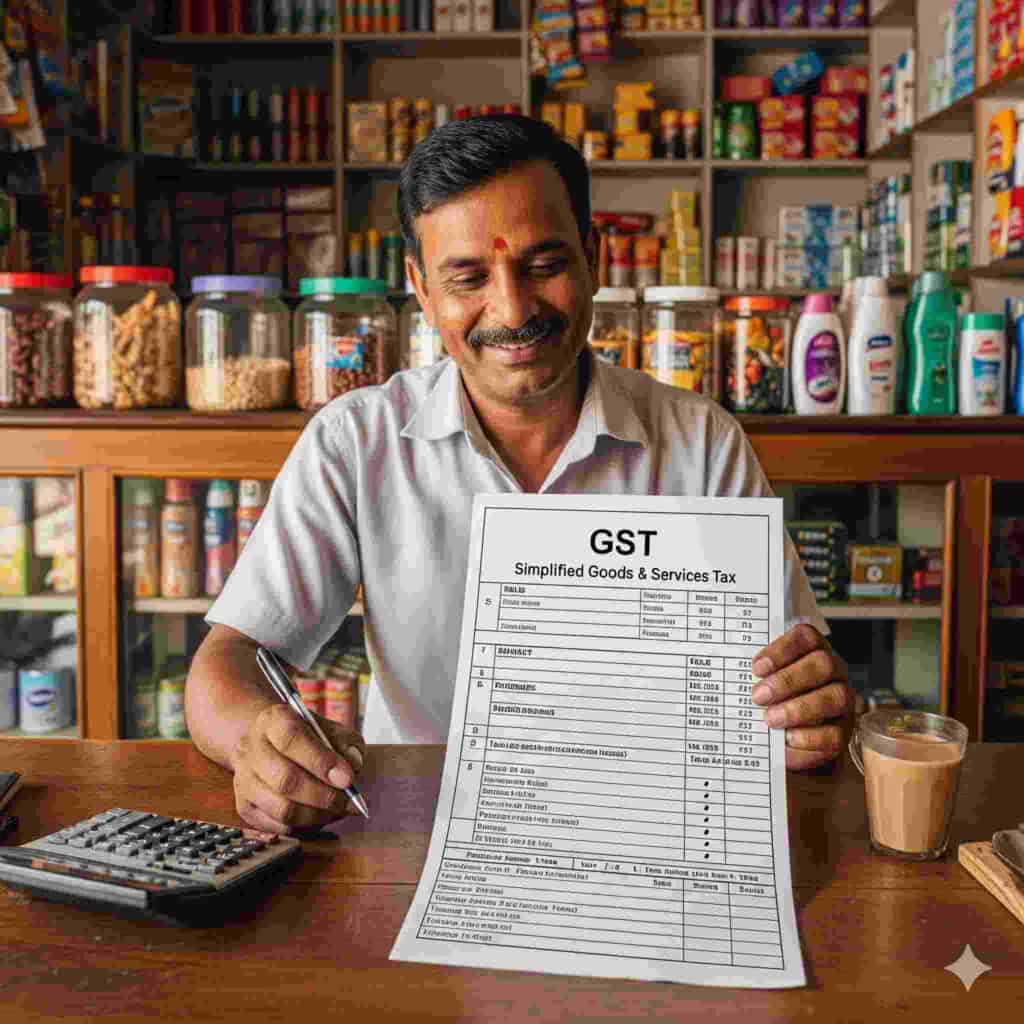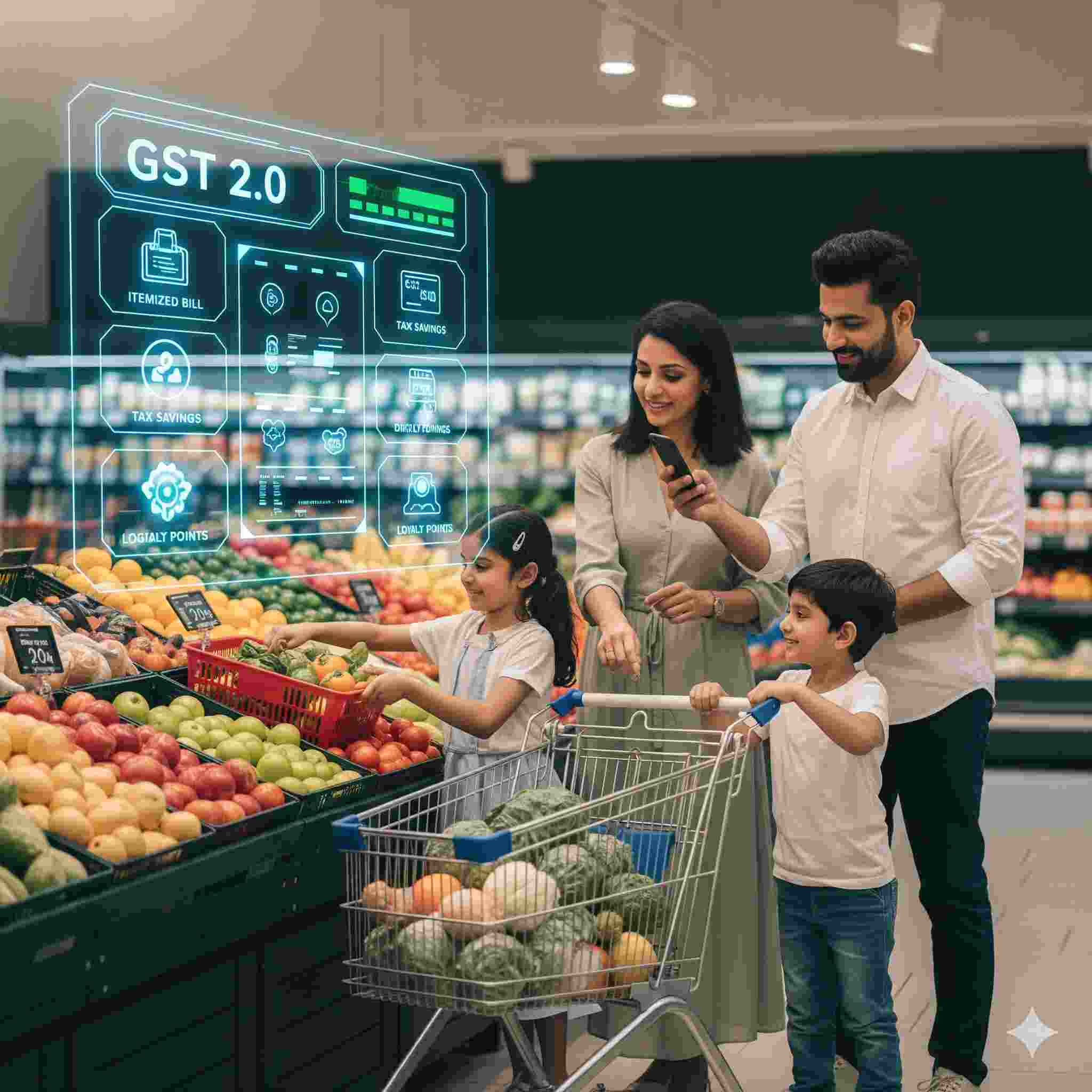Remember when GST was first introduced in 2017? You probably thought, “Finally, one nation, one tax!” But then came the confusion of multiple slabs – 5%, 12%, 18%, 28% – making even a simple grocery bill feel like solving a math puzzle. Well, here’s some good news that’ll make your September brighter than expected.
On September 3, 2025, Finance Minister Nirmala Sitharaman announced GST 2.0 – the most significant tax reform since GST’s original launch. Starting September 22, 2025, India will move to a simplified two-slab structure of 5% and 18%, along with a special 40% rate for luxury and sin goods. You might be wondering how this affects your monthly budget, your family’s expenses, or your small business. Let’s break it down in simple terms
The Big Simplification: From Four Slabs to Two
Think of your current GST experience – you buy soap (18% GST), then pick up some biscuits (also 18%), grab cement for home renovation (28% GST), and end up paying different rates for similar everyday items. It’s confusing, right?
GST 2.0 changes this completely. The new structure is refreshingly simple:
- 5% (Merit Rate): Essential items that every household needs
- 18% (Standard Rate): Most goods and services
- 40% (Demerit Rate): Luxury cars, tobacco, and sin goods
- 0% (Exempt): Basic necessities like milk, bread, and now health insurance
This means no more scratching your head wondering why similar products attract different tax rates. The government has essentially said, “Let’s make this easier for everyone.”
How GST 2.0 Affects Your Daily Life

The Salaried Professional: Meet Rahul from Mumbai
Rahul, a 32-year-old employee in Mumbai, spends roughly ₹15,000 monthly on groceries and household essentials. Under the old system, he was paying 18% GST on items like shampoo, soap, and toothpaste.
Here’s what changes for Rahul:
- Hair oil, shampoo, and toiletries: 18% → 5% (saves about ₹400 monthly)
- Packaged foods like biscuits and namkeens: 18% → 5%
- Health insurance premium: 18% → 0% (saves ₹2,700 annually on a ₹15,000 premium)
When Rahul plans to buy a new LED TV this Diwali, it’ll cost him 10% less as the rate drops from 28% to 18%. That’s a saving of ₹5,000 on a ₹50,000 television!
The Middle-Class Family: The Sharma Household
Consider the Sharmas, a typical Delhi family with two school-going children. Mrs. Sharma runs the household budget while Mr. Sharma works in a private company. Their monthly expenses include school supplies, groceries, and occasional dining out.
What gets cheaper for the Sharmas:
- School notebooks and pencils: 12% → 0% (completely tax-free)
- Geometry boxes and educational supplies: 12% → 5%
- Butter, ghee, and dairy products: 12% → 5%
- Their car insurance renewal will be tax-free instead of 18% GST
The real impact: A family spending ₹25,000 monthly could save approximately ₹1,500-2,000 per month, which adds up to ₹18,000-24,000 annually.
See From Shampoo to Cement: What Gets Cheaper After GST 2.0 in India
Small Business Owners: Simplified Compliance

Meet Surya, who runs a small garment shop in Pune. Earlier, she struggled with classifying products under different GST slabs – some fabrics at 5%, readymade garments at 12%, and premium clothing at 18%.
GST 2.0 benefits for Priya:
Better cash flow: Automated and faster refund processes
Simpler classification: Only two main categories to worry about
Faster GST registration: New businesses get approval within 3 working days
Reduced compliance burden: Fewer categories mean fewer mistakes and dispute.
The Bigger Picture: Why This Matters for India’s Economy
GST 2.0 isn’t just about tax rates – it’s a strategic move to boost domestic consumption when the economy needs it most. With global uncertainties and trade tensions, India is focusing on strengthening internal demand.
Economic experts predict:
- GDP boost: Estimated 40 basis points increase in economic growth
- Inflation control: Simpler structure reduces price volatility
- Consumption stimulus: More money in middle-class pockets before the festive season
- Manufacturing boost: Lower input costs for key industries
The timing is strategic too – implementing these changes before Diwali 2025 aims to boost festive demand and consumer sentiment.
Actionable Insights: What You Should Do Now
For Families:
- Review your monthly budget – You’ll likely save 8-12% on essential items
- Plan big purchases – TVs, ACs, and small cars are now more affordable
- Consider health insurance – With 0% GST, coverage becomes significantly cheaper
- Track your savings – Use apps like ClearTax or ET Money to monitor how much you’re saving
For Small Businesses:
- Reclassify your inventory – Understand which items fall under 5% vs 18%
- Update your billing systems – Ensure compliance with new rates from September 22
- Take advantage of simplified registration – If expanding, new registrations are now faster
- Plan for working capital relief – Faster refunds mean better cash flow
For Investors:
- Watch FMCG and consumer stocks – Companies selling essential items may see margin expansion
- Consider real estate – Cheaper cement could boost the housing sector
- Monitor inflation trends – GST 2.0 could help keep inflation in check, affecting interest rates
Looking Ahead: What This Means for Your Financial Planning
GST 2.0 represents more than just tax reform – it’s a shift toward simplicity and consumer-friendly policies. For the average Indian family, this translates to real savings that can be redirected toward investments, emergency funds, or long-term financial goals.
The reduction in everyday expenses means you might finally have that extra ₹2,000 monthly to start a SIP or boost your emergency fund. With health insurance becoming tax-free, there’s no excuse not to get adequate coverage for your family.
For businesses, the simplified structure reduces compliance costs and disputes, allowing entrepreneurs to focus on growth rather than paperwork. This could accelerate India’s journey toward a more formalized economy.
Conclusion
GST 2.0 delivers on Prime Minister Modi’s Independence Day promise of reducing the tax burden on common people. By moving from four slabs to two, the government has chosen simplicity over complexity, affordability over revenue maximization for essential goods.
The math is simple: if you’re a typical Indian family spending on necessities, you’ll save money. If you’re a small business owner, compliance becomes easier. If you’re planning big purchases like cars or appliances, they’re now more affordable.
Starting September 22, 2025, when you check out at your local grocery store or pay your insurance premium, remember – GST 2.0 is putting more money back in your pocket, just in time for the festive season.
What do you think about these changes? Will GST 2.0 make a real difference to your family’s budget? Share your thoughts in the comments below.
